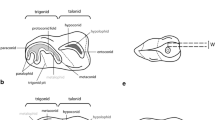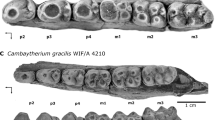Abstract
Wear stages have been defined based on dentine exposure at the lower molar surfaces for a population of the extant bat Pipistrellus pipistrellus (6 wear stages) and for a sample of the Oligocene bat Pseudorhinolophus antiquus (4 wear stages). Wear stages 1–2, which occur in juveniles, are characterised by punctual dentine exposure on the cusps and ridges. Wear stages 3–4, found in adult individuals, are characterised by connected areas of band-shaped dentine. The last two wear stages (5–6) reflect the dental condition of old (senile) individuals, with the molar surface showing wide areas of exposed dentine and the occlusal relief drastically reduced. The defined wear stages of the P. antiquus sample are comparable to stages 3–6 of P. pipistrellus. The molars of both species show wear facets with striations that go in two directions, indicating a two-phased, bucco-lingually directed masticatory movement which gains more freedom with progressive wear. This development underlines that shear-cutting dominates in the early stages of the mastication process, whereas in later stages a crushing component becomes increasingly dominant. Based on the average age determination of individuals from the defined wear stages, about 90 % of the studied P. pipistrellus population consists of juveniles (wear stages 1–2). In contrast, wear stages 3–5 (95 %) predominate in the studied sample of P. antiquus, indicating that most of the individuals were of an adult/senile age.






Similar content being viewed by others
References
Anders, U., von Koenigswald, W., Ruf, I., & Smith, B. H. (2011). Generalized individual dental age stages for fossil and extant placental mammals. Paläontologische Zeitschrift, 85(3), 321–339.
Barclay, R. M. R., & Harder, L. D. (2003). Life histories of bats: life in the slow lane. In T. H. Kunz & M. B. Fenton (Eds.), Bat Ecology (pp. 209–253). Chicago: The University of Chicago Press.
Brunet-Rossinni, A. K., & Wilkinson, G. S. (2009). Methods for age estimation and the study of senescence in bats. In T. H. Kunz & S. Parsons (Eds.), Ecological and Behavioral Methods for the Study of Bats (pp. 315–325). Baltimore: Johns Hopkins University Press.
Cakenberghe, V. van, Herrel, A., & Aguirre, L. F. (2002). Evolutionary relationships between cranial shape and diet in bats (Mammalia: Chiroptera). In P. Aerts & F. d. Vree (Eds.), Topics in functional and ecological vertebrate morphology: A tribute to Frits de Vree (pp. 205–236). Maastricht: Shaker Publishing.
Crompton, A. W. (1971). The origin of the tribosphenic molar. In D. M. Kermack & K. A. Kermack (Eds.), Early Mammals (Vol. 1, pp. 65–87). London: Academic Press.
Dietz, C., Helversen, O. V., & Nill, D. (2007). Handbuch der Fledermäuse Europas und Nordwestafrikas. Biologie, Kennzeichen, Gefährdung. Kosmos-Naturführer. Stuttgart: Kosmos.
Dumont, E. R. (1995). Enamel thickness and dietary adaptation among extant primates and chiropterans. Journal of Mammalogy, 76(4), 1127–1136.
Foley, J., Clifford, D., Castle, K., Cryan, P., & Ostfeld, R. S. (2011). Investigating and managing the rapid emergence of white-nose syndrome, a novel, fatal, infectious disease of hibernating bats. Conservation Biology, 25(2), 223–231.
Freeman, P. W. (1998). Form, function, and evolution in skulls and teeth of bats. In T. H. Kunz & P. A. Racey (Eds.), Bat biology and conservation (pp. 140–156). Washington, D.C.: Smithsonian Institution Press.
Gunnell, G. F., & Simmons, N. B. (2005). Fossil evidence and the origin of bats. Journal of Mammalian Evolution, 12(1–2), 209–246.
Hand, S. J., Sigé, B., & Maitre, E. (2012). Necromantis Weithofer, 1887, large carnivorous Middle and Late Eocene bats from the French Quercy Phosphorites: new data and unresolved relationships. In G. F. Gunnell & N. B. Simmons (Eds.), Evolutionary History of Bats. Fossils, Molecules, and Morphology (pp. 210–251). New York: Cambridge University Press.
Horáček, I., & Špoutil, F. (2012). Why tribosphenic? On variation and constraint in developmental dynamics of chiropteran molars. In G. F. Gunnell & N. B. Simmons (Eds.), Evolutionary History of Bats. Fossils, Molecules, and Morphology (pp. 410–455). New York: Cambridge University Press.
Koenigswald, W. von., Anders, U., Engels, S., Schultz, J. A., & Kullmer, O. (2013). Jaw movement in fossil mammals: analysis, description and visualization. Paläontologische Zeitschrift, 87(1), 141–159.
Krapp, F. (2004). Gattung Pipistrellus Kaup, 1829 (mit Bemerkungen zu Hypsugo Kolenati, 1856). In J. Niethhammer & F. Krapp (Eds.), Handbuch der Säugetiere Europas Band 4: Fledertiere, Teil II: Chiroptera II (pp. 757–814). Wiebelsheim: Aula-Verlag.
Kulzer, E. (2005). Handbuch der Zoologie, VIII Mammalia, Teilband 62. Chiroptera. Volume 3: Biologie. Berlin: Walter de Gruyter.
Lucas, P. W., Omar, R., Al-Fadhalah, K., Almusallam, A. S., Henry, A. G., Michael, S., Thai, L. A., Watzke, J., Strait, D. S., & Atkins, A. G. (2013). Mechanisms and causes of wear in tooth enamel. Implications for hominin diets. Journal of the Royal Society Interface, 10(80), 20120923.
McKenna, M. C., Bell, S. K., & Simpson, G. G. (1997). Classification of mammals above the species level. New York: Columbia University Press.
Roer, H. (1979). 1180 Zwergfledermäuse (Pipistrellus pipistrellus Schreber) in Entlüftungsrohren eines Gebäudes verendet. Myotis, 17, 31–40.
Roer, H. (1981). Zur Heimkehrfähigkeit der Zwergfledermaus (Pipistrellus pipistrellus Schreber, 1774) (Mammalia: Chiroptera). Bonner Zoologische Beiträge, 32(1–2), 13–30.
Ryan, A. S. (1979). Wear striation direction on primate teeth: a scanning electron microscope examination. American Journal of Physical Anthropology, 50, 155–168.
Schultz, J. A., & Martin, T. (2011). Wear pattern and functional morphology of dryolestoid molars (Mammalia, Cladotheria). Paläontologische Zeitschrift, 85(3), 269–285.
Sevilla, P. (1990). Rhinolophoidea (Chiroptera, Mammalia) from the Upper Oligocene of Carrascosa del Campo (Central Spain). Geobios, 23(2), 173–188.
Simmons, N. B. (2005). Order Chiroptera. In D. E. Wilson & D. M. Reeder (Eds.), Mammal species of the World: a taxonomic and geographic reference (3rd ed., pp. 312–529). Baltimore: Johns Hopkins University Press.
Simmons, N. B., & Geisler, J. H. (1998). Phylogenetic relationships of Icaronycteris, Archaeonycteris, Hassianycteris, and Palaeochiropteryx to extant bat lineages, with comments on the evolution of echolocation and foraging strategies in Microchiroptera. Bulletin of the American Museum of Natural History, 235, 1–182.
Simmons, N. B., Seymour, K. L., Habersetzer, J., & Gunnell, G. F. (2008). Primitive early Eocene bat from Wyoming and the evolution of flight and echolocation. Nature, 451(7180), 818–821.
Slaughter, B. H. (1970). Evolutionary trends of chiropteran dentitions. In B. H. Slaughter & D. W. Walton (Eds.), About bats, a chiropteran biology symposium (pp. 50–83). Dallas: Southern Methodist University Press.
Smith, T., Habersetzer, J., Simmons, N. B., & Gunnell, G. F. (2012). Systematics and paleobiogeography of early bats. In G. F. Gunnell & N. B. Simmons (Eds.), Evolutionary History of Bats. Fossils, Molecules, and Morphology (pp. 23–66). New York: Cambridge University Press.
Storch, G. (1999). Order Chiroptera. In G. E. Rössner, K. Heissig, & J. A. Alcover (Eds.), The Miocene land mammals of Europe (pp. 81–90). München: Verlag Dr. Friedrich Pfeil.
Swift, S. M., Racey, P. A., & Avery, M. I. (1985). Feeding ecology of Pipistrellus pipistrellus (Chiroptera: Vespertilionidae) during pregnancy and lactation. II. Diet. The Journal of Animal Ecology, 54(1), 217–225.
Thenius, E. (1989). Zähne und Gebiss der Säugetiere. In J. Niethhammer, H. Schliemann, & D. Starck (Eds.), Handbuch der Zoologie. VIII Mammalia (Vol. 56, pp. 98–110). Berlin: Walter de Gruyter.
Acknowledgements
We thank Gregg F. Gunnell and an anonymous reviewer for their comments which helped to improve our manuscript. We are grateful to Rainer Hutterer for providing the large sample of P. pipistrellus material housed in the Forschungsmuseum Alexander Koenig (Bonn, Germany). We also thank Benedict Crowe for checking the English grammar of the manuscript. This is publication number 74 of the DFG research unit 771.
Author information
Authors and Affiliations
Corresponding author
Rights and permissions
About this article
Cite this article
Hielscher, R.C., Schultz, J.A. & Martin, T. Wear pattern of the molar dentition of an extant and an Oligocene bat assemblage with implications on functionality. Palaeobio Palaeoenv 95, 597–611 (2015). https://doi.org/10.1007/s12549-015-0186-z
Received:
Revised:
Accepted:
Published:
Issue Date:
DOI: https://doi.org/10.1007/s12549-015-0186-z




